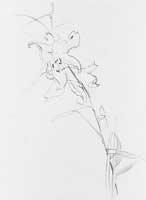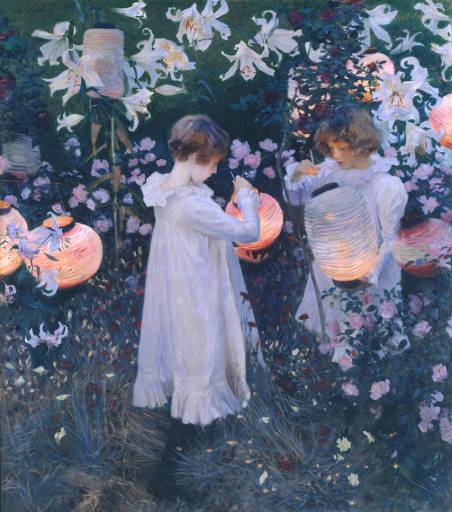
Carnation
Lily Lily Rose
16
x 20 in.
or

Carnation
Lily Lily Rose
31
x 23 in.

Broadway,
The Cotswolds, England |
 |
Francis
Davis Millet

Mr.
Sargent at work on Carnation, Lily, Lily, Rose
1885-65 |

Photo:
Sargent painting at Broadway
1885-86 |
Studies
|
|

Study of
Polly Barnard for 'Carnation, Lily, Lily, Rose'
c. 1885
|

Dorothy Barnard
1885
|
Study
of Barnard Children for Carnation, Lily, Lily, Rose (graphite)
1885-86 |

Lily Study for "Carnation, Lily, Lily, Rose"
1885-86
|

Japanese Lanterns and Lilies, Study for "Carnation, Lily,
Lily, Rose"
1885-86 |

Back of Child's Head
1885-86
|

Studies for Flowers for "Carnation,
Lily, Lily, Rose"
1880-85
|

Studies for Flowers for "Carnation, Lily, Lily, Rose"
1880-85 |

Study of Flowers and Lanterns; verso:
Studies for "Carnation, Lily, Lily, Rose;" Comic Heads
1880-85
|

Girl with Lantern
1880-85 |
|
Carnation,
Lily, Lily,
Rose [1]
John
Singer Sargent
-- American painter
1885-1886
Tate
Gallery, London,
England
Oil on canvas
174 x 153.8 cm
(68 1/2
x 60 1/2 in.)
Purchased from
the artist,
1887
Jpg: Tate
Gallery
(Click on image to Step
Closer)
Conceived under the
most unusual
of circumstances, and nurtured in a remarkable setting at Broadway,
this
painting is overwhelmingly held out by the public -- then as well as
today
-- to be the most favored painting of all his work. It is universally
believed
to be one of his masterpieces. Carnation, Lily, Lily, Rose, the
title lifted from the light-hearted lyrics of a popular song, is a
triumph
of John's use of light which would never be equaled in quite the same
way.
 The
seed of the idea was first planted in the fertile garden of the
Lavington
Rectory in 1884 when Sargent was staying with the Vickers. The white
lilies
in full bloom around the two children in a garden would be the
framework
on which he would mount this most ambitious project. The idea (a purely
fanciful one to be sure) was to capture, not the most perfect sunset,
but
the affect of the most perfect sunset has, in terms of color, shadows
and
light on a scene. But it was more than that. How about the artificial
light
of Chinese lanterns at the precise moment of twilight when lanterns and
sun are at perfect equilibrium! -- Could he paint that magical
transient
moment that lasts no more than
a couple of minutes most -- capture that
most perfect color of mauve when the sun is still flush in the sky and
the lanterns glowing equally? Not create the scene from his mind
or memory of what it would or should look like, but actually capture it
-- could he paint the exquisite beauty between those two
minutes? The
seed of the idea was first planted in the fertile garden of the
Lavington
Rectory in 1884 when Sargent was staying with the Vickers. The white
lilies
in full bloom around the two children in a garden would be the
framework
on which he would mount this most ambitious project. The idea (a purely
fanciful one to be sure) was to capture, not the most perfect sunset,
but
the affect of the most perfect sunset has, in terms of color, shadows
and
light on a scene. But it was more than that. How about the artificial
light
of Chinese lanterns at the precise moment of twilight when lanterns and
sun are at perfect equilibrium! -- Could he paint that magical
transient
moment that lasts no more than
a couple of minutes most -- capture that
most perfect color of mauve when the sun is still flush in the sky and
the lanterns glowing equally? Not create the scene from his mind
or memory of what it would or should look like, but actually capture it
-- could he paint the exquisite beauty between those two
minutes?
Of course not. No
one could paint
in two minutes and even come close to a faithful adaptation no matter
how
prepared he or she was prior. But what if he painted only for those
magical
minutes every day? If he was faithful, if he kept true to the
principles
of Impressionism -- painting only what he saw and not what he thought
he
saw or wanted to see, if he did it every day for two minutes could he
capture
lightning in a bottle so to speak?
It was silly, but
the idea was hatched
in a community of people that weren't constrained by the blinders of
convention.
These were people who could see things that weren't and ask way not?
Sargent
was going to do the impossible and they were all going to help!
He started off by
using Mrs. Millet's
young daughter who was only 5 at the time. They put a wig on her to
lighten
her hair and then propped the poor thing up as if she were
lighting
a Chinese lantern. Everyone in the community took an interest, but the
demands of maintaining an exact pose every day proved to be too much;
so
in her place Mrs. Barnard's two girls stepped in of a more
appropriate
age of seven and eleven.
Edmund
Gosse wrote: "The progress of the picture, when once it began to
advance,
was a matter of excited interest to the whole of our little
artist-coloney.
Everything was used to be placed in readiness, the easel, the canvas,
the
flowers, the demure little girls in their white dresses,before we began
our daily afternoon lawn tennis, in which Sargent took his share. But
at
the exact moment, which of course came a minute or two earlier each
evening,
the game was stopped, and the painter was accompanied to the scene of
his
labors. Instantly, he took up his place at a distance from the canvas,
and at a certain notation of the light ran forward over the lawn with
the
action of a wag-tail, planting at the same time rapid dabs of paint on
the picture, and then retiring again, only with equal suddenness to
repeat
the wag-tail action. All this occupied but two or three minutes, the
light
rapidly declining, and then while he left the young ladies to remove
his
machinery, Sargent would join us again, so long as the twilight
permitted,
in a last turn at lawn tennis"
(Sir Edmund Gosse
letter to Charteris
, P74-75)
"The seasons went
from August till
the beginning of November "Sargent would dress the children in white
sweaters
which came down to their ankles, over which he pulled the dresses that
appeared in the picture. He himself would be muffled up like an Artic
explorer.
At the same time the roses gradually faded and died, and Marshall and
Snelgrive
had to be requisitioned for artificial substitutes, which were fixed to
the withered bushes . . . . In November, 1885, the unfinished
picture
was stored in the Millets' barn. When in 1886 the Barnard children
returned
to Broadway the sittings were resumed.
(Charteris , P75)
For Sargent it
seemed the fun was
in the process. Edwin Howland Blashfield recalled that when he saw the
canvas each morning, the previous evening's work seemed to have been
scraped
off, and that this happened repeatedly at each stage.
(Tate)
"Never for any
picture did he do
so many studies and sketches. He would hang about like a snapshot
photographer
to catch the children in attitudes helpful to his main purpose. 'Stop
as
you are,' he would suddenly cry as the children were at play, "don't
move!
I must make a sketch of you," and there and then he would fly off,
leaving
the children immobile as Lot's wife, to return in a moment
with easel, canvas and
a paint-box.
(Charteris , P74)"
Notes
1) The lyrics in an
earlier version
of Joseph Mazzinghi's song (circa Joseph Mazzinghi's life) has the line
punctuated as "Carnation lily, Lily rose."
I should be the
last to point out
grammatical disparities (and I'm more than a little surprised I caught
it) but reading the title as Mazzinghi might have meant the line to
read,
lets it roll off the tongue more lyrically rather than the plodding --
thump, thump -- as it is now.
It would be
interesting to see how
early in the literature this incorrect form first started. Of course
the
line was meant to be sung and Sargent's intent would have been in the
cadence
of the song itself. I wonder if Sargent's title was always writen this
way?
More
on the song that
inspired
the painting

|
|

Ye
Shepherds Tell Me
Composed
& arranged for the piano in 3 voices (overlapping lyrics and
harmony)
forte
by
Joseph Mazzinghi (1765-1844)

[first
voice lead]

Ye
Shep-herds tell me, tell me have you seen, have you seen My Flo-ra pass
this way? In shape and feature beau- - -ty's queen. In pastoral,
in pas-to-ral ar-ray

[Chorus]

Shepherds
tell me, tell me have you seen, have you seen My Flo-ra pass this way?
Have you seen, tell me Shepherds have you seen, tell me have you seen
My
Flo-ra pass this way. _____

[second
voice takes lead]

A
wreath a- -round her head, around her head she wore Car-na-
-tion, lil-ly, lil- - -ly, rose; And
in her hand a crook she bore, And sweets . . . her breath
compose.

[Chorus]

Shepherds
tell me, tell me have you seen, have you seen My Flo-ra pass this way?
Have you seen, tell me Shepherds have you seen, tell me have you seen
My
Flo-ra pass this way. _____

The
beau-teous, the beauteous wreath that decks, that decks her head, Forms
her descrip-tion, her de-scription true. Hands lily white, Lips
crim-son
red, and cheeks of ro-sy, ro-sy hue.


See
more about Song
|


Mrs.
Frederick Barnard
1885
(mother
to Barnard children)
|




